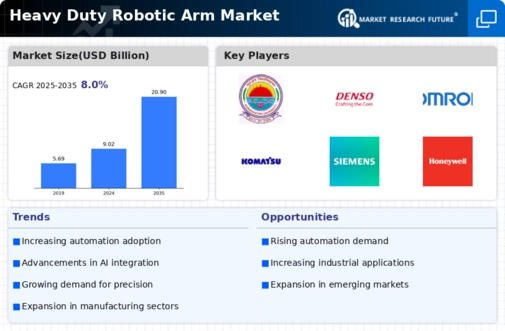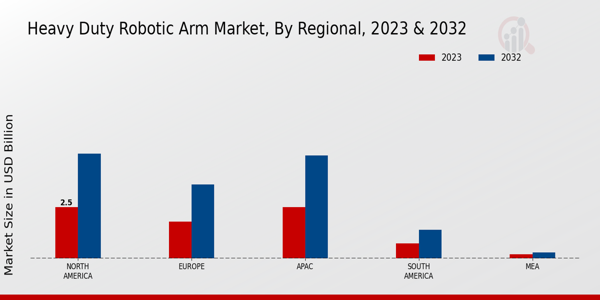Market Growth Projections
The Global Heavy Duty Robotic Arm Market Industry is projected to experience substantial growth over the next decade. With a market value anticipated to reach 20.9 USD Billion by 2035, the industry is on a trajectory of robust expansion. The compound annual growth rate of 7.96% from 2025 to 2035 indicates a strong upward trend, driven by factors such as technological advancements, increased automation, and rising labor costs. This growth trajectory suggests that the Global Heavy Duty Robotic Arm Market Industry will continue to evolve, adapting to the changing needs of various sectors and enhancing operational efficiencies.
Technological Advancements
Technological advancements play a pivotal role in shaping the Global Heavy Duty Robotic Arm Market Industry. Innovations in artificial intelligence, machine learning, and sensor technologies enhance the capabilities of robotic arms, enabling them to perform complex tasks with precision. For example, the integration of AI allows robotic arms to adapt to varying production requirements, optimizing their performance. These advancements not only improve operational efficiency but also expand the application range of heavy-duty robotic arms in sectors such as aerospace and pharmaceuticals. As a result, the market is expected to grow significantly, potentially reaching 20.9 USD Billion by 2035.
Rising Demand for Automation
The Global Heavy Duty Robotic Arm Market Industry experiences a notable surge in demand for automation across various sectors, including manufacturing, construction, and logistics. Industries are increasingly adopting robotic arms to enhance productivity and efficiency, thereby reducing operational costs. For instance, automotive manufacturers utilize heavy-duty robotic arms for assembly lines, which streamlines production processes. This trend is expected to contribute to the market's growth, with projections indicating a market value of 9.02 USD Billion in 2024. As industries continue to embrace automation, the Global Heavy Duty Robotic Arm Market Industry is poised for substantial expansion.
Growing Focus on Safety and Precision
The Global Heavy Duty Robotic Arm Market Industry is increasingly driven by a growing focus on safety and precision in industrial operations. Companies are prioritizing the implementation of robotic arms to minimize workplace accidents and ensure high-quality production standards. Heavy-duty robotic arms are designed to operate with high accuracy, reducing the likelihood of errors in manufacturing processes. This emphasis on safety and quality is particularly relevant in sectors such as pharmaceuticals and food processing, where compliance with stringent regulations is essential. As industries seek to enhance safety measures, the demand for heavy-duty robotic arms is expected to rise.
Increased Investment in Infrastructure
Increased investment in infrastructure development globally is a driving force behind the Global Heavy Duty Robotic Arm Market Industry. Governments and private sectors are allocating substantial resources to enhance infrastructure, including transportation, energy, and construction projects. Heavy-duty robotic arms are employed in these projects for tasks such as material handling, welding, and assembly, which enhances efficiency and safety. For instance, in large-scale construction projects, robotic arms can operate in hazardous environments, reducing the risk to human workers. This trend is expected to bolster the market, as infrastructure investments continue to rise in the coming years.
Labor Shortages and Workforce Challenges
The Global Heavy Duty Robotic Arm Market Industry is significantly influenced by labor shortages and workforce challenges faced by various sectors. As industries grapple with a declining labor pool, particularly in skilled positions, the adoption of robotic arms becomes a viable solution to maintain productivity levels. Heavy-duty robotic arms can perform repetitive and physically demanding tasks, alleviating the burden on human workers. This trend is particularly evident in manufacturing and warehousing, where companies are increasingly investing in automation to counteract labor shortages. Consequently, the market is likely to witness a compound annual growth rate of 7.96% from 2025 to 2035.














